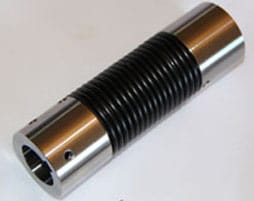Lovejoy coupling uni joints
Table of Contents
The flexible shaft coupling we will discuss today is the universal joint. Originally invented in the 1683 by Robert Hooke the Hooke joint became the universal joint when patented in 1905 by Clarence Spicer. The Spicer joint then with Spicer’s business partner Charles Dana turned into the current day Dana Holdings.
Lovejoy coupling uni joints design while similar to the Spicer universal joint is broken into two different offerings
Lovejoy couplings like all universal joint manufacturers all revolve around the same design, so all u joints are the same, some of the internal components are different, the hubs can be made stronger but that also increases the price. The universal joint is all the same whether a friction bearing block and pin or a needle bearing type.
The couplings are the same and have the same issues of maintenance and a lack of flexibility. This lack of flexibility added to the maintenance required to make the coupling continue to function due to the build up of heat and the grease or lubrication that is required to keep the universal joint functioning.
Lovejoy couplings design while similar to Spicer U joints are broken into two different offerings, these couplings or universal joint regardless of type still are a 3 part design so contains bearing cross and two hubs or yokes.
The two include the Friction bearing and Needle bearing (the needle bearing model is the coupling that is the same as the Spicer Universal joint), they have two variations of the needle bearing coupling as well, the standard version or the premium which basically is a updated pre-greased bearing for longer life.
This comes at a increase in price and while this will increase the useful life of the bearing cross it too will need to be replaced as either the lubrication runs out or the bearings themselves just wear out and need replacement due to equipment failure or bearing failure
Block and Pin universal joint
Block and Pin universal joint is a simple design, a center block with 4 holes through it which holds 2 pins thus block and pin universal joint.
Block and pin Advantages – A u joint which is a high strength but low speed universal joint, Its a great low cost option to allow some industries that only need a low speed low misalignment shaft coupling that needs high strength. The applications usually are not mission critical, as the couplings are not able to used in 24/7 setting
Block and Pin Disadvantages – While it is high strength it can only run at low speed as the coupling can only run at low speed because at higher speed the block starts to heat up leading to failure due to pin binding (generated heat makes the 2 pins expand leading to making the block seizing in the middle of the coupling)
Due to the simple nature of the coupling, its ability to be used in a large misalignment angle is normally ruled out as the increase of vibration will result in equipment damage and that is the other reason it has to be used at low speed.
The universal joints regardless of manufacturer has two hubs, a input hub and a output hub, these are used to connect from the input (motor or power source) to the output (usual a shaft or wheel etc.)
What models are available
Twin Spring Couplings current offerings compare to the following Lovejoy block and pin universal joint
D-5B and D-6B and D-6SSB is comparable to our TSC150
D-6B and D-7B and D-8SSB is comparable to our TSC300
D-7B and D-8B and D-10SSB is comparable to our TSC500
Needle bearing universal joint
Lovejoy coupling Needle bearing universal joints are more closely related to the Dana Spicer u joints, and it also marks the departure from the simple universal joint design, both with simplicity (component count) and operating speed (6000 RPM compared to 1750RPM)
Needle bearing Advantages – The advantages are two fold, an increase in angle of misalignment and an increase in speed of operation. The needle bearings means the angle of misalignment can increase to 25 degrees with less heat and more importantly no real increase in vibration.
The speed increases from only 1750RPM with the block and pin to 6000RPM with the needle bearings. This is due to the fact that the needle bearings are constantly greased which reduces friction and thus reduces the heat generated at the higher speeds.
The other advantage of using the needle bearings is that the joint itself is able to be used at a higher angle of misalignment due to the bearings allowing a great range of misalignment verses the block design. This means both higher speed and larger angle of misalignment which makes it useable in far more industries and different applications.
Needle Bearing Disadvantages – The disadvantages are also two fold with the improved performance also means increased maintenance and increased replacement of wear parts, being the bearings.
With the bearings now included inside the coupling the increased speed increases the friction so the bearings need to be constantly filled with grease to stop the needles in the bearing from expanding with the heat and seizing inside the race, the grease absorbs the heat rather than the needles bearings.
This means that the grease will dry with use and will constantly need to be replaced, this increases the overall cost of the coupling as the increase in maintenance costs lowers the ROI of the couplings.
Another disadvantage with the inclusion of the bearings is, while they improve the flexibility of the coupling they also wear out as the bearings are used outside their typical usage, so the bigger the angle of misalignment they are used at, the increased rate of wear the bearings encounter since the needles are being forced against the side of the bearing cage.
This force wears the needle ends and bearing cage so the more force applied (ie bigger misalignment angle) means the needle bearings wear quickly and the bearing needs to be released sooner.
Twin Spring Couplings current offerings compare to the following Lovejoy needle bearing universal joint
NB-6B is comparable to our TSC150
NB-8B is comparable to our TSC300
NB-10B is comparable to our TSC500
How does Twin Spring Coupling differ from Lovejoy coupling universal joints
The Twin Spring Coupling has a number of advantages over the typical universal joint
No bearings so no greasing or replacing worn bearings
Twin torsion spring design means increased flexibility with increased torque
No central bearings or block , one central ball acts as the pivot point for the coupling, one ball means annual greasing, reducing maintenance costs
One piece design means input and output hubs are integrated into the coupling making it a one piece design verses a three piece design with a universal joint.
Spring design allow absorption of vibration and shock into coils reducing the likelihood of damage to sensitive equipment
The combination of the twin spring design means the same amount of flexibility as a universal joint but without the block and pin or needle bearings means it produced less heat but can still be ran at both low and high speeds means the best of both universal joint designs but without the downsides of either.
Available in all the same bore sizes, keyway sizes as well as the most common shaft sizes means it is a simple replacement for either of these two universal joints with the only difference being is the Twin Spring Coupling is slightly longer.
This is because of the increased flexibility and the thickness of the torsion spring coils to account for the torque requirements of the machinery.
Time to improve on a 350 year design
Twin Spring Coupling when 1 is better than 3
For more information on our couplings go to
https://twinspringcoupling.com/industries/industrial-couplings/

